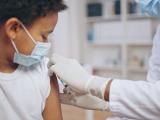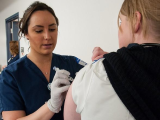May 14, 2008 – ATLANTA (CIDRAP News) – The drive to increase the number of Americans who get vaccinated against influenza may stumble on disagreements within medicine and public health over where vaccination should take place.
Over several hours Tuesday, participants at the annual National Influenza Vaccine Summit struggled with the competing goals of getting shots and nasal sprays into as many patients as possible, while protecting the investments of the patients' regular doctors and the entrepreneurship of alternative vaccination sites.
Doctors' representatives complained that vaccine orders appear to go first to large-scale vaccination programs that draw away patients. But community and alternative vaccinators replied that some physician practices are referring patients to public health clinics in order to avoid the uncompensated discussion time needed to deal with patients' fears of vaccines.
Meanwhile, the US Department of Health and Human Services (HHS) announced a new program that it hopes will stimulate public confidence in flu vaccine, by encouraging healthcare workers within HHS to take the nasal spray or shot.
'Medical home' versus maximum coverage
The debate over where vaccination takes place centers on the concept of a "medical home," an idea that was advanced by the Institute of Medicine in 2001 and described in a 2007 white paper signed by four medical associations. That paper recommends that a single physician take responsibility for delivering a patient's care, monitoring the network of other providers the patient deals with, and collecting all reports about the patient into a single record.
The goal is to avoid fragmentation. But flu vaccination challenges that concept because it is deliberately delivered in a fragmented manner, via doctors' offices, public clinics, pharmacies, workplace campaigns, grocery stores and other sites. That ad hoc system developed, with health authorities' approval, to ease the pressure of administering large amounts of vaccine in a short period of time. But summit participants said the unintended consequence has been to steer at least information and in some cases patients away from primary care physicians.
"We all value the medical home, we want patients cared for in a medical home, but statistics . . . show that 48% of family practice [physicians] will refer outside of the medical home to public health" for vaccination, said Patricia Stinchfield of the Children's Hospitals and Clinics of Minnesota, who spoke on behalf of the National Association of Pediatric Nurse Practitioners. Describing a late-season rush to vaccination following several deaths from flu in Minnesota, she said, "People went to their medical home and their medical home said, 'We did that in October, so find someplace else.'"
A deep-rooted misconception
Vaccinations are not taking place because patients and medical staff alike think of flu vaccine as something given only in the fall, according to several participants at the meeting, which drew 230 people.
"I have to fight my staff every month," said Dr. Kim Dixon, an internist at St. Peter's University Hospital in New Jersey. "In January, the nurses sent all the vaccine vials back to the central pharmacy from our clinic site and I told them to get them back. In February, it was the same thing."
The summit was founded in 2001 following a vaccine shortage to give flu vaccination's many participants—public health, clinical medicine, manufacturers, and distributors, among others—a chance to express frustration and work out strategies. The shortage problem has since vanished: Last year manufacturers delivered a record number of doses, and 19% of them went unused. But the frustration over uneven distribution remains.
"If I don't have the vaccine Oct. 1 but a retail organization down the street has it, and I have a patient who wants flu vaccination, they will go down the street," Dixon said. "And that is fine, because they should be vaccinated. But now I have a vaccine for a patient who is not going to get it in my practice. It is a really hard thing each year, especially when we can't count on a firm delivery date, to figure out how much vaccine will be utilized."
About half of the vaccine sold in the United States each year is sold directly by the manufacturers, with the other half passing through 15 to 20 middlemen, according to Andrew van Ostrand of the Health Industry Distributors Association. But the new vaccine does not flow evenly into the marketplace: Once distribution begins, manufacturers may release anywhere from 1 to 39 lots of 400,000 to 500,000 doses each week.
Who should get first shipments?
There have been persistent complaints through the years over who appears to receive vaccine first, with doctors saying they should get first choice because they see the patients at highest risk of flu complications. But that may not be true: 10% of vaccine given in workplace programs goes to high-risk patients, said Roslyn Stone, chief operating officer of Corporate Wellness, Inc.
"The best data that we have shows that high-risk patients are getting served in a wide variety of places," said Dr. Jeanne Santoli of the Centers for Disease Control and Prevention. "We have gone on record with the manufacturers and distributors, asking that they treat all the types of providers as equitably as possible . . . so that vaccination can start everywhere" as close to the same time as possible.
Some summit participants urged new outreach efforts, such as offering vaccination to family members who pick up prescriptions for others or bring elderly parents or pregnant women for appointments, and one described offering shots for cash to the parents of pediatric patients. But "the biggest barrier is reimbursement," said Mitchel Rothholz, chief of staff of the American Pharmacists Association. "From the pharmacy perspective, it is getting recognized to be a provider for those patients. And a pediatrician may not be seen by a third-party payer as someone who can treat an adult patient."
Persuading healthcare workers
With so much vaccine going unused, several groups are turning their attention to boosting public confidence in the flu vaccine. Some called for an easily recognizable symbol that could be worn by recipients, similar to breast-cancer ribbons or "I voted" stickers. But others said the best promotion for flu shots and nasal sprays would be for patients to hear that their own caregivers have received it—something that often cannot be said now because, according to the CDC, only 42% of healthcare workers get vaccinated against flu.
Unvaccinated healthcare workers may not realize they are a risk to their patients, said Dr. Donald Wright, principal deputy assistant secretary for health at HHS—but studies show that one in four unvaccinated workers contracts flu each year. Fewer than half of them recall being sick, suggesting they could have transmitted flu without knowing they were contagious.
Wright said surveys show that healthcare workers have the same mistaken beliefs about flu shots and nasal sprays as the general population: They fear it will cause side effects, or think they do not need it because they are healthy or not at risk. So HHS will launch a program later this year to persuade health care workers to be vaccinated, starting with its own personnel. The goal will be to raise the vaccination rate to 60% by 2010, he said.
See also:
February 2007 report "Joint Principles of the Patient Centered Medical Home"
http://www.aap.org/en-us/professional-resources/practice-support/quality-improvement/pages/Joint-Principles-of-the-Patient-Centered-Medical-Home.aspx


















